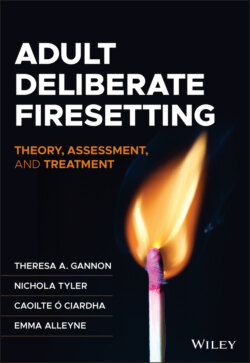Adult Deliberate Firesetting

Реклама. ООО «ЛитРес», ИНН: 7719571260.
Оглавление
Theresa A. Gannon. Adult Deliberate Firesetting
WILEY SERIES IN FORENSIC CLINICAL PSYCHOLOGY
Adult Deliberate Firesetting. Theory, Assessment, and Treatment
Contents
List of Illustrations
List of Tables
Guide
Pages
About the Authors
Preface
Acknowledgments
1 Deliberate Firesetting A Prevalent Yet Neglected Clinical Issue
Definitions, Terms, and Labels
Prevalence of Deliberate Firesetting
Adult Firesetting as a Neglected Topic of Research
Key Developments in the Childhood Firesetting Literature
Sexual Offending Literature as a Guiding Framework
Book Rationale
Concluding Remarks
Note
2 Key Characteristics and Clinical Features of Individuals Who Set Deliberate Fires
Characteristics of Adults Who Set Fires. Sociodemographic Findings
Developmental Context
Mental Disorder and Psychopathology
Psychological Traits
Characteristics of Subgroups of Adults Who Set Fires
Limitations of the Literature and the Current Review
Conclusions, Ways of Working, and Future Directions
3 Theories of Deliberate Firesetting Refreshing the M-TTAF
Effective Psychological Theory
Typological Explanations of Firesetting
Single-Factor Theories
Micro-process Theories
Multi-factorial Theories
Refreshing the M-TTAF
Fire Scripts
Personality Disorders
Minor Diagrammatical Changes to Tier 1
Changes to Tier 2
Unidentified Trajectories
Conclusions, Ways of Working, and Future Directions
4 Conducting Best Practice Risk Assessments in Deliberate Firesetting
Prevalence of Firesetting Recidivism
Risk and Protective Factors: The Basis for Assessment
Risk and Protective Factors for Repeat Firesetting
Risk Assessment Protocols
Firesetting Risk Assessment Tools
Risk Assessment Using the Multi-Trajectory Theory of Adult Firesetting (M-TTAF)
Information-Gathering Process
Clinical Formulation
Conclusions, Ways of Working, and Future Directions
Note
5 Un-apprehended Deliberate Firesetting: Can We Intervene?
Prevalence
Characteristics and Psychological Features
Gender
Developmental Experiences
Offending or Antisocial Behaviour
Psychopathology
Psychological Features
Motivation
Fire Scene Behaviours
Preventing Deliberate Firesetting
Existing Prevention Strategies
Un-apprehended Deliberate Firesetting: Informing Prevention
Conclusions, Ways of Working, and Future Directions
6 Assessment and Treatment for Apprehended Adults Who Have Set Deliberate Fires
Assessing Adult Firesetting
Fire-setting Assessment Schedule (Murphy & Clare, 1996)
Fire Setting Scale (Gannon & Barrowcliffe, 2012)
Fire Proclivity Scale (Gannon & Barrowcliffe, 2012)
Four Factor Fire Scale (#211; Ciardha et al., 2015b, 2015c)
Firesetting Questionnaire (Gannon et al., in preparation)
Treatment of Adult Firesetting
Generalist Interventions
Specialist Interventions
Conclusions, Ways of Working, and Future Directions
7 Engaging and Working Therapeutically with Individuals Who Have Set Deliberate Fires: A Strengths-Based Approach
Who Should Receive Treatment for Firesetting?
Group Composition
Common Fears and Apprehensions Regarding Firesetting Treatment. Firesetting-Specific Themes
General Themes
Navigating Group Work
Developing a Strong and Cohesive Group
Using Group Member Strengths Effectively
Denial
Inappropriate Group Behaviour
A Note on Collaborative Working and Modularisation
Considerations for Working with Specific Populations. Women
Individuals Experiencing Mental Illness
Conclusions, Ways of Working, and Future Directions
Note
8 What Next? The Future of Firesetting Research and Practice
Developments and Priorities. Theoretical Understanding
Assessment
Treatment
General Research Considerations
Concluding Comments
References
Index
WILEY END USER LICENSE AGREEMENT
Отрывок из книги
Edited by
Clive R. Hollin
.....
Given the paucity of the adult firesetting literature pre-2010, researchers turned to more established literatures (i.e., sexual offending) to inform the research agenda moving forward. However, although early theorising suggested a relationship between firesetting and sexual dysfunction, little available evidence substantiates this link as a major explanatory factor for adult firesetting (Ó Ciardha, 2015). Research on sexual offending has nonetheless been influential in developing knowledge relating to firesetting. This is likely the result of the longstanding recognition of sexual offending—particularly child sexual abuse—as a public health problem in need of sustained research to develop knowledge for prevention and treatment. As a result, the burgeoning field of research on deliberate adult firesetting has been able to draw on practices and concepts from the more established field of research on sexual offending.
A key influence of the field of sexual offending on firesetting research has been work by Tony Ward and various collaborators. The Multi-Trajectory Theory of Adult Firesetting (M-TTAF; Gannon et al., 2012) is an example of theorising in firesetting that draws inspiration from work, including that of Ward and Beech (2006), Ward and Hudson (1998), and Ward et al. (2006), on how to effectively develop, appraise, and knit together theories in sexual offending. Models of the offence process (micro theories) of firesetting behaviour (e.g., Barnoux et al., 2015; Tyler et al., 2014) also used methods applied by Ward et al. (1995) to the investigation of the offence process of people who sexually offend against children. Furthermore, Ward hypothesised that implicit theories (Ward, 2000; Ward & Keenan, 1999) and offence scripts (Ward & Hudson, 2000) form part of an explanatory framework for the offence-supportive belief systems of people who commit sexual offences. These concepts have been highly influential in theory development (e.g., Butler & Gannon, 2015; Ó Ciardha & Gannon, 2012; see Chapter 3) and empirical research (e.g., Barrowcliffe et al., 2019; Butler & Gannon, 2021) on firesetting behaviour.
.....